Basketball: The 1-2-2 zone defense
Changing your defenses during the course of a game can be very effective. I have found a 1-2-2 zone can be modified on the fly by making calls from the bench. It also can be adjusted to fit your personnel.
The first step is to learn the basic rules of a 1-2-2 zone that we call ”12 Stay.” From there, you can change the defense over the course of the year to have the full package in by season’s end.
’12 Stay’
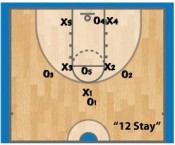 DIAGRAM 1: This is the basic 1-2-2 (12 Stay) set. X1 is usually your smallest, quickest guard responsible for getting the ball out of the middle.
DIAGRAM 1: This is the basic 1-2-2 (12 Stay) set. X1 is usually your smallest, quickest guard responsible for getting the ball out of the middle.
X1 has ball responsibility whenever the ball is above the foul line. X2 and X3 must stop any gap drives. X4 and X5 will stay on the blocks.
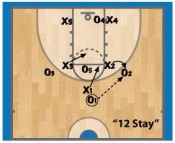 DIAGRAM 2: When the ball is passed to the wing, X1 sinks to cover the high post. X2 and X3 have ball responsibility.
DIAGRAM 2: When the ball is passed to the wing, X1 sinks to cover the high post. X2 and X3 have ball responsibility.
If the ball is on the opposite wing, they must sink to the middle and help with the high post. X4 and X5 must front the ball-side post. When away from the ball, they must sink to the middle to stop any lobs.
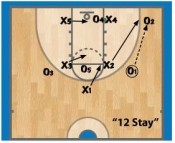 DIAGRAM 3: If the ball is entered into the corner instead of the wing, X2 and X3 must follow the ball.
DIAGRAM 3: If the ball is entered into the corner instead of the wing, X2 and X3 must follow the ball.
X4 and X5 must stop any baseline drives.
’12 Go’
“12 Go” is good against a team with quality outside shooters, especially in the corners. It helps if X2 and X3 are tall, because they are responsible for fronting the post. It is also important for X4 and X5 to be very aggressive on the ball to stop entry passes to the post.
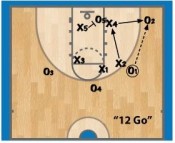 DIAGRAM 4: When the ball is passed to the corner, X4 and X5 step out to cover it being very aggressive to stop the entry pass. If not on the ball side, they must help the ball side until the wing gets there.
DIAGRAM 4: When the ball is passed to the corner, X4 and X5 step out to cover it being very aggressive to stop the entry pass. If not on the ball side, they must help the ball side until the wing gets there.
X2 and X3 dive to the ball-side post and front the block. X1 has the same responsibilities as in 12 stay.
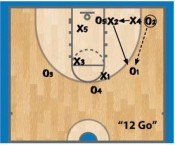 DIAGRAM 5: When the ball is reversed back to the wing, X2 and X3 must hustle back to the wing. X4 and X5 return to front the block.
DIAGRAM 5: When the ball is reversed back to the wing, X2 and X3 must hustle back to the wing. X4 and X5 return to front the block.
’12 Trap’
“12 Trap” is an excellent half-court or three-quarter-court trap. The idea is to trap the ball along the sideline and force turnovers. Stress to your players that most steals come from the player in the passing lane, not the ones doing the trapping.
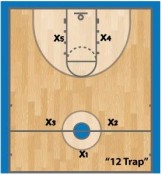 DIAGRAM 6: This is the basic set. X1 picks up the ball at three-quarter court or half-court and tries to force the ball to one side. X1 tries to get on the side of the ball handler but does not allow a split.
DIAGRAM 6: This is the basic set. X1 picks up the ball at three-quarter court or half-court and tries to force the ball to one side. X1 tries to get on the side of the ball handler but does not allow a split.
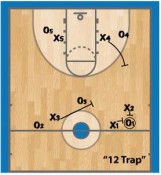 DIAGRAM 7: X1 and X2 must trap at the side line and cannot allow the ball to split them. If the ball is away, they must cover the middle and deny at all costs.
DIAGRAM 7: X1 and X2 must trap at the side line and cannot allow the ball to split them. If the ball is away, they must cover the middle and deny at all costs.
X4 and X5 to the ball side must be ready to come up and steal a long pass. The offside defender must protect the basket.
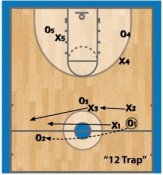 DIAGRAM 8: On a reversal pass, X1 must sprint to the ball and force it into a trap. X2 and X3 does not leave the middle until the opposite guard bumps them from the responsibility.
DIAGRAM 8: On a reversal pass, X1 must sprint to the ball and force it into a trap. X2 and X3 does not leave the middle until the opposite guard bumps them from the responsibility.
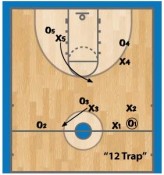 DIAGRAM 9: If X1 and X2 (or X3 if on the left) have a good sideline trap, X3 can leave the middle to steal the reversal pass. If X3 leaves, then X5 runs to the middle looking for a steal.
DIAGRAM 9: If X1 and X2 (or X3 if on the left) have a good sideline trap, X3 can leave the middle to steal the reversal pass. If X3 leaves, then X5 runs to the middle looking for a steal.
’12 Corner’
“12 Corner” can be run as its own defense or as something to fall back into after the offense breaks the 12 Trap. It runs the same as “12 Go” until the ball goes into the corner.
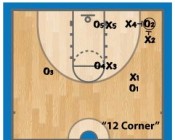 DIAGRAM 10: When the ball goes into the corner, X2 follows the ball into the corner to set up a trap with X4.
DIAGRAM 10: When the ball goes into the corner, X2 follows the ball into the corner to set up a trap with X4.
X1 rotates to face guard to the ball side to deny the ball reversal. X3 steps over to deny the high post if a player is there; if not X3 looks to steal the lob. X5 moves around to front the ball-side post. This is where a majority of your steals will come from.
The hole in this coverage is that you will give up the lob to the opposite side. To prevent this you need an aggressive trap. If the ball is reversed, everyone must scramble back to their position.












